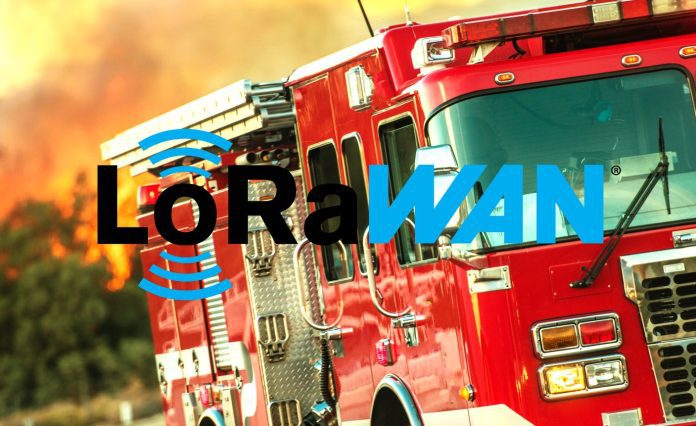Various updates from LoRa-land, and beyond… Semtech, the owner of LoRa tech and licensing, said environmental IoT provider ICT International, is using LoRa-based devices on LoRaWAN networks to improve urban forest management and carbon accounting. ICT International’s “plant physiology devices” are able to monitor the health of the urban forest in real time across a LoRaWAN connection, according to a release from Semtech.
ICT International has developed a LoRa-based SFM1L sap flow meter and PSY1 stem psychrometer; the devices have been deployed throughout cities in New South Wales, in Australia, to identify the ongoing water requirements of the “urban forest”. The first measures water consumption by plants, and the second measures “water stress” (PSY1) in plants; data is transmitted to the cloud via a LoRaWAN access network.
A statement said: “The products are able to measure plant water use (sap flow), soil moisture and vapor pressure deficit, and can identify periods of low soil moisture and high plant water stress. Addressing these factors quickly can help trees remain healthy, providing valuable ecosystem services to the community as well as measurable carbon capture.”
Peter Cull, managing director at ICT International, commented: “The urban forest provides valuable eco services such as carbon sequestration through photosynthesis and cooling through shade and evapotranspiration… The urban forest represents the only interaction with nature that many of the world’s population have on a day-to-day basis. With increasing urbanization… the value placed on the urban forest is increasing.”
Marc Pégulu, vice president of IoT strategy and products for Semtech’s wireless and sensing products group, said: “ICT International’s utilization of LoRaWAN for its sensors is a great example of how low-power wide-area (LPWA) networks can create a smart city and a better and healthier planet for all. The real-time monitoring enabled by the LoRaWAN connectivity is providing actionable data to the forest’s surrounding city water allocation and irrigation departments to make decisions on maintaining the health of the urban forest.”
Meanwhile, US LoRaWAN operator Senet has said it is working with environmental IoT sensor maker Thingy IOT (not to be confused with Nordic Semiconductor’s Thingy:91 module) to deliver LoRaWAN-connected wildfire and air quality monitoring systems in the western US. Senet said it will verify interoperability of the Thingy AQ sensor with its cloud-based network management platform, and Thingy IOT will become a Senet RAN operator partner.
Thingy IOT will build out LoRaWAN infrastructure in areas without coverage. It will also operate private networks and applications for agriculture, research, and government agencies. The deal means public agencies and firefighting organizations, along with farmers and researchers, will have a clearer path to deploying and managing scaled LoRaWAN deployments for remote air quality sensors to help detect wildfires and monitor wildfire smoke.
Scott Waller, chief and co-founder at Thingy IoT, said: “Over the past few years we have been implementing one-off networks everywhere we place sensors. Now, as a Senet RAN and virtual network partner, we have significantly better network and device deployment and management tools, allowing us to scale our sensor deployments and improve the reliability of the data used to track wildfires.”
Elsewhere, French gateway maker Kerlink is working with air-quality monitoring firm Sensgreen to help “ensure offices, schools, hotels, malls and other facilities have clean air in comfortable indoor settings”. Their offer combines Sensgreen’s SensNode air-quality sensor – which monitors temperature, humidity, dew point, CO2, particulate matter, and other parameters – with Kerlink’s Wirnet gateways and Wanesy management platform in private LoRaWAN settings.
A statement said: “Air-quality data collected by SensNode is transferred to the cloud via Kerlink gateways. This allows building operators and workplace managers to see the measurements and calculations of parameters on a dashboard developed by Sensgreen. Using real-time and historical data, they can then adjust their HVAC systems to maintain their desired air-quality conditions and ensure building energy-efficiency goals are met.”
Kerlink has also introduced a new indoor LoRaWAN gateway for “cities, factories, warehouses, and buildings”. The new Wirnet iZeptoCell gateway is designed to support key ‘massive IoT’ criteria in LPWA and LoRaWAN networks, including huge numbers of endpoints, remote and dispersed coverage, and rising volumes of data traffic. Kerlink said the new product “embodies a brand-new fully operational design combining hardware, software and value-added services that are critical for massive IoT”.
Meanwhile (as well), Semtech has introduced a new line of (non-LoRa) sensors for the consumer devices market. Its new PerSe (a portmanteau of ‘person sensing’) sensors – PerSe Connect, PerSe Connect Pro, and PerSe Control – are for regular-duty consumer smartphones, laptops, and wearables to “sense” human presence near consumer electronics devices – and “enable advanced RF control when the user is in close proximity”.
The sensors measure specific absorption rate of electronics devices, counting the RF energy absorbed by the human body when in close proximity to a connected device. Their low power and diminutive footprint also make the new sensors ideal sensing for a range of wearable applications such as gesture control and automation, said Semtech.
A statement said: “Smartphone manufacturers can now deliver high-quality connectivity in 5G/Wi-Fi 6 with increased RF performance in their smartphones and laptops, while also helping ensure compliance with the worldwide SAR regulations, keeping consumers connected and safe. PerSe provides best-in-class sensing performance and robust noise immunity allowing original equipment and device manufacturers to design devices with longer detection distance within a smaller sensor area.”
David Wong, senior director of consumer sensing products for Semtech’s wireless and sensing products group, said: “Semtech works closely with the industry’s top consumer electronics manufacturers developing and implementing our sensors to deliver incredible connectivity and provide an automated user experience, while also complying with SAR regulations… PerSe sensors deliver an unmatched consumer experience through device performance, regulatory compliance, user safety, and business impact.”

